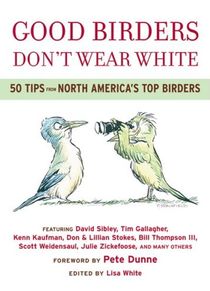Reviewed by Grant McCreary on March 8th, 2008.
In the forward of this book, Pete Dunne calls it “the greatest compilation of birding know-how of all time”. That’s very high praise, especially from someone of Dunne’s stature. Let’s see if it is deserved…
As the subtitle of the book suggests, it is composed of 50 tips from some of the best that birding has to offer. They are broken down into 14 categories:
- Bird feeding
- Equipment/Clothing
- Identification
- Birding tours/trips
- When and where to bird
- Listing
- Bird sounds
- Birding etiquette
- Weather
- Conservation
- Photography/Drawing
- Enjoying birds and birding
- Birding with kids
- Becoming an expert
The title and author of each of the 50 articles is available in the table of contents at the publisher’s website.
The majority of the tips contain good, basic information that birders should know to enjoy their hobby to the fullest. There is basic information for beginners, suggestions on how to graduate into becoming an expert, and everything in between. It is likely that there will be some ideas that will be new to anyone. For example, one tip suggests that by waving a white cloth you can entice waterfowl to swim closer. The chapters range in tone from completely tongue-in-cheek to serious, thus keeping the reader from becoming bored.
The main issue with the tips is their brevity. This is a small book, both in terms of dimensions and page count, thus each article is by necessity very short. They average 4-5 pages each. Most of them feel not fully fleshed-out, as if they were heavily edited. By the time you really get into some of them, the article ends. Donald Kroodsma’s tip on getting to know the individual singers of the songs you hear is one such case. It’s a fascinating topic that is just crying out for more details and examples than could be included here. Thankfully in this instance you can find more in his wonderful book, The Singing Life of Birds (very highly recommended, by the way).
As with any such book of tips, its usefulness is inversely related to one’s skill. That is, top birders won’t learn much here. Most of the articles will still be pleasurable to read, and there will be some good reminders, but not much new information. However, it may open up the world of birding for beginning and intermediate birders, especially if they use the tips here as a springboard into further study, such as going on to read Kroodsma’s aforementioned book.
There are also 25 full-page black and white line drawings by Robert Braunfield interspersed throughout the book. These usually depict concepts from the tips in a humorous fashion. They are quite amusing and are a welcome addition.
With all due respect to Mr. Dunne, I have to disagree with his assessment of this compilation. I think that his own Pete Dunne on Bird Watching would be more deserving of the title Greatest Compilation of Birding Know-how. However, it is a handy assembly of tips and would still be a good choice for anyone wanting to be a better birder.
Disclosure: I get a small commission for purchases made through links in this post.





[…] The Birder’s Library […]
wonderful review. Thanks. If I hadn’t already a HUGE stack of bird books on my desk to read, I would read that one, especially now that it’s so cheap.